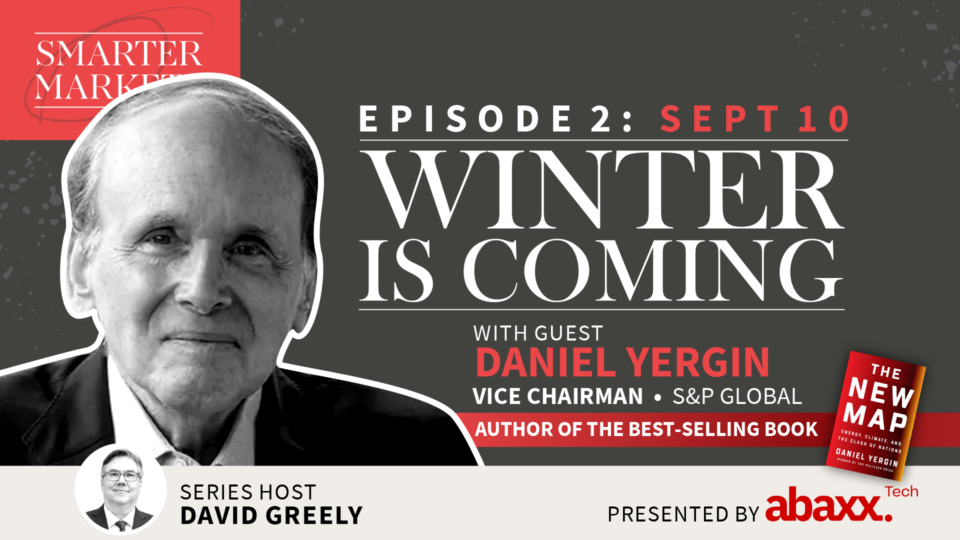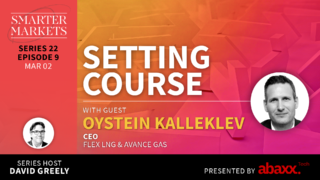In this episode, host David Greely welcomes energy icon and Vice Chairman of S&P Global, Daniel Yergin, to discuss EU energy crisis warnings and calls for immediate solutions spread across global headlines.
Covering everything from his predictions in The New Map: Energy, Climate and the Clash of Nations to S&P’s recent Future of Copper Report — Greely and Yergin pack a half hour with insights on Europe’s energy crisis and its impact on our road to decarbonization, and what’s next now that Winter is Coming.
Hosted By
Episode Q&A
The following Q&A is created using slightly edited excerpts from the episode transcript, optimized for readability. Download full transcript.
DY: This energy crisis did not start on February 24 when Russia invaded Ukraine; it really started roughly a year ago, in September of 2021, when the markets began to tighten because of preemptive underinvestment in conventional energy sources. It was an economic development rather than a geopolitical one. Although Russia had begun pulling back on supplies, normally, prices would go up, and we put more gas in, but strangely enough, Russia didn’t do it, and that contributed to higher prices. So maybe this was a warm-up for what was going to come with February 24 to put the Europeans in a more difficult position, which was one of Putin’s miscalculations. He thought that Europe’s heavy dependence on Russian energy would mean that they wouldn’t protest but just wave through Ukraine, just like the annexation of Crimea had been accepted.
DY: Now Putin is doing something that the Soviet Union said they would never do. They would never use energy as a weapon and were a reliable supplier. Putin is now using it as a weapon, and he laid out his strategy in June at the St. Petersburg International Economic Forum. He said explicitly that high prices would bring Europe to economic hardship, which would cause social tension and problems, which might bring populous parties to power and change the elites in Europe, undermining the coalition that supports Ukraine. And that is exactly what he is trying to do. And It looks like he has this one victory under his cap, which is Italy, where Mario Draghi, who went to Kyiv on a train to commit Italy’s support to Ukraine, is being pushed out of power by one of the far-right parties, which withdrew from the coalition. So now you have the situation where Europe is reeling from prices that people never imagined that they would see.
In a way, it reminds me of the energy crisis of the 1970s, when you had the collision between a global energy crisis and the global geopolitical crisis. This isn’t just about markets anymore. It’s about the whole system under stress because Putin is using gas as a weapon. It puts pressure on big companies and on smaller companies, not just in England, but people and families closing down their bakeries and shops because they can’t afford it. Plants and fertilizers shutting down because energy is too expensive. This may not be so well perceived in the United States or other parts of the world, but Europe is in a very difficult situation. It’s highly likely that Europe will be in a recession by the fourth quarter.
I think it will change; the world after the crisis in the 70s was different than the world before. The world after this crisis is going to be different. If we go back 30 years, the collapse of the Soviet Union brought down barriers for the first time after the Bolshevik Revolution. As a result, you had an integrated global market. People didn’t know until February that the US was importing half a million barrels a day of Russian oil for its east coast refineries to help them run more efficiently and produce more products. There always was politics, but it was also about efficiency. You had global markets and energy, oil, gas, and coal flowing from Russia, an investment in technology flowing into Russia, and the development of a global gas market.
And we have the big four LNG exporters: Qatar, Australia, the United States, and Russia. The barriers have gone up again because Europe has said we’re not going to import Russian energy anymore, and I think unless there’s a major change in Russia, there’s no going back from that. But they haven’t really prepared themselves for that, and so it can be very difficult for them to do. It’s just changes and flows; India never imported Russian oil. Now I think it’s either the largest or second-largest importer of Russian oil because they get it at a discount. So what we have is a restructuring of the global markets. It’s only the beginning, and there’s no more single market and investment flows around the world anymore, now it’s going to be a fragmented market. Generally speaking, we’re heading into this kind of new era of fragmented and divisive globalization.
Certainly a new chapter, because obviously the world changes, but the last sentence at the bottom of Page 78 said Ukraine was the issue that was going to blow up between Russia and the West, and it happened. I didn’t necessarily envision that it would happen this way, but you could just see that this was a tinderbox, and it was a focus because it reflected on the fact that Putin did not accept the outcome of the cold war. He did not accept the outcome that Ukraine was a separate country and gas was so intertwined with it. One of the primary reasons why Russia was building Nord Stream 1 and Nord Stream 2 was so they don’t have to send gas through Ukraine, through which most of their gas historically had gone to Europe. I wrote in the book a lot about how this relationship between Putin and Xi has developed between Russia and China.
And at the book, I had a scene describing being at the St. Petersburg conference in 2019 and watching when Putin’s guest was Xi and Putin began the conversation by apologizing, he said, President Xi, we kept you up until 4 o’clock your time, with talking, and Xi said, we never have enough time to talk, and then I thought, what do they talk about? One of the main things they talk about is that they don’t like the international global economic and political order that, in their view, the US dominates. They don’t see it as a multilateral system; we see now that Russia’s basically headed to become economically dependent on China. The other thing that I wrote about, which is unfolding right now, was explaining why we’re seeing this movement from the WTO consensus in which China, and the United States, were all in this together and all benefiting from globalization and that China would be a responsible stakeholder and all those terms, but now we have a great power competition. And in the book, I explain how this came about, why, and where I think the next crisis could be.
Let me divide this into two parts: the Europeans and the US. The European consumers are surely worried about this because they’re living with it, and those consumers are also the voters; there is a big very concern about a social disorder that can ensue. And they’re struggling to figure out how you manage this. And now, the focus has been to get as much gas to the winter’s storage as possible, which has contributed to the higher prices. But now the question is how do we cap the prices, do we subsidize, do we send money to consumers, how do we handle this, and that’s what they’re struggling with. You’re going to hear a lot about price caps of one kind or another, the US proposal for price caps on Russian oil, the European proposals for price caps on natural gas, or windfall profits.
And of course, the other response you’ve had in the US is the so-called Inflation Reduction Act, which doesn’t seem to have much to do with inflation, except maybe it’ll drive up the cost of minerals, but a lot to do with the Industrial Policy Act 2022, which is a pretty massive intervention in the energy markets and in the effort to change will cost a lot, and will probably end up costing a lot more because it always is.
I think it’s a dicey situation because Putin, from his point of view, has to win his war, and breaking the coalition, creating confusion and disarray, is a central objective of it. He’s going to throw everything into it. I think, at the end of the day, the Europeans are going to hang together because they look at the Ukraine war as a war in Europe, and there’s lots of apprehension about what if Putin succeeds here, what’s next? So Russia can’t be allowed to win. And that’s why it’s very hard for people to see what the way out is here, and of course, what’s making it more complicated is that one side has nuclear weapons, and the other side, NATO has nuclear weapons too, and this has caused terror. And then you have this nuclear power plant in Ukraine that was taken over by Russians, which they treat like war booty, and this comes with grave danger and higher responsibility.
If something bad happens at the nuclear power plant, the west really needs to say that basically, Putin uses nuclear weapons, but in a different form. I think getting through the next few months will be critical element, and there is a new player in the global energy market now, and it’s called the US Federal Reserve and the other Central Banks, and you have already seen that the cost of bringing down the prices may result in stagnation or recession. And the prices are very volatile, and things could change tomorrow. Prices would come down further if there’s an Iran nuclear deal, and more Iranian oil prices would go up if China got out of COVID restrictions and went back to old oil consumption levels. And for the federal reserves, a form of price management would be relentlessly raising interest rates.
The Germans have certainly been talking about, and not only the Germans, but the imminence of some kind of rationing, and I think Germany has been preparing for it. Preparing for the decisions about who gets gas, who should be the priority among industries? Because you don’t want to short-change the industry and then have unemployment. I think that would qualify as a war footing. Intervention in the market price caps that’s like a war footing. Some have compared this intervention by the US government to the war footing intervention of World War II. For Europe now, this is the question of economic life and death, and it’s also about political survival for current European leaders. For the European politicians who are currently holding office, they don’t want to have the Mario Drughi scenario.
The best scenario is that Europe gets the gas storage full and will be running ahead of schedule. At the moment, they are around 85% as we’re speaking today, and if it’s a mild winter, that would be the best outcome. The worst outcome is a social breakdown, and governments can’t stand the pressure. A recession turns into something worse than a recession. Putin thought the war would be over in three days and his officers, when invading Ukraine on their way to Kyiv, brought their dress uniforms for the ceremonial parade, didn’t turn out that way. World War 1 was supposed to be a short war but turned into trench warfare. So we don’t know how things will go, and there is the additional danger that Russia is a nuclear power. Putin has already talked four or five times about using nuclear weapons. He seems now to back away from that because he doesn’t know what the repercussions would be. And certainly, there are even worse case scenarios, but I prefer not to go there. I prefer to go with gas storage filled and warm winter.
From the energy point of view, relieving the pressure on Europe, not a recession, but an economic slowdown, and see where it takes and the people’s behavioral responses. We also do see price responses. For example, gasoline demand in the US now is maybe 6% to 8% less than it was this time last year. So we shouldn’t forget that every price is a little piece of information that tells people what to do. Higher gasoline prices hit teachers, nurses, and people driving to work, but now gasoline prices are down, and that is partially because people have found ways to reduce consumption. So I think prices itself is an important factor here, and they always say that the solution for high prices are high prices because they bring low prices.
There is also a larger question about investment. Two questions. One is that preemptive under-investment is a real problem because energy, oil, and gas demand will continue to grow. You can’t tell emerging markets that they can’t have energy and one of the things I wrote about in “The New Map” book, is about the merchants of this new north-south divide are the developing countries saying, hey, you can’t tell us that we can’t use natural gas instead of having people burn wood in indoor cooking, you won’t finance that. And by the way, you do want to finance more natural gas terminals. Another thing I’ve been working on is about a world of big shovel mining.
At S&P Global, we have just concluded this big study on copper, and it’s very interesting. We look closely at the Biden 2050 goals and the EU 2050 goals. What does that mean, technology by technology and sub-technology by sub-technology, and how much copper would you need? We picked on copper because copper is the metal of electrification. We saw that you get this energy transition demand on top of existing demand, and guess what there’s not enough supply. Supply would have to double to meet the demand embodied in these goals by 2035. Look at Chili, they have a new president, and they are aiming to tax copper production and restrict mining, put limitations on it, and make permits harder. So why does Chili matter? Because Chili is the source of 25% of the world’s copper. Chili and Peru together are 38% of the world’s copper, and 42% is smelted in China.
Absolutely! Over the last couple of decades, the amount of copper produced in the United States has declined by half, and now try getting a permit. The IEA says the international energy agency says it’s 16 years on average from discovering a resource to the first production, and what they left out is the other 15 years of litigation as it works its way through the courts in the United States.
Well, people are not anticipating that you’re going to see a lot of inflation in the cost of the materials that are required for the energy transition, and it may get more expensive. Now people may look at solar panels and wind turbines and see the incredibly dramatic drop in cost; solar down 90% and wind costs going even more down. So now people are just extrapolating that those costs will continue to fall. But, in truth, if everybody rushes to the same side of the boat at the same time, it will not be a smooth sailing anymore. And I think that this question of where you’re going to get the materials from, for instance, half the world’s cobalt comes from the Democratic Republic of the Congo. And you can go down the list and this just issues with permits to mine around the world.
Then South Africa, same issues with permits. It’s gets harder to do this, and then still you need so much more. In the copper study we mention a new supply, greater efficiency in mining and recycling are all those necessary elements. But at the same time, if we talk about, recycling, iron steel, for instance, can be recycled, but these other things, you have to gather all the stuff on a scale. It was really interesting looking at copper because, factually, copper is not on the critical minerals list of the US government, which is really odd. You need it for electrification. The assumption that just you can do all this really quickly, that everybody can have an electric car and offshore wind.
I know that electric car takes at least two and a half times more copper than a conventional car, and maybe with innovation, they can reduce it. When California declared that all cars sold in the state have to be electric by 2035. Let’s multiply every one of those, whatever the amount of copper, let’s multiply it by 2.5. Did they figure that in the legislation? Probably not. Copper is a good example because you just see where the supplies come from and then, of course, there’s a famous phrase called the obsolescent bargain. Let’s say David Greely Inc. makes an investment in a developing country. You have a festive dinner and signed all he papers and everybody agrees on it. And so it goes, and he price goes up and down in the market. Then a new government comes in and they have no vested interest in the deal and so they tell you that they made too good of a deal to get you to invest your money here. Let’s change it because you’ve already invested, and so the bargain becomes obsolescent. And suddenly the cost goes up. As sure as the sun rises, that’s exactly what is going to happen with these minerals and resources as they will become more important for the energy transition. Most people are not thinking about it in the context of how economic history unfolds.
That’s a very good point! It would be interesting to see, for instance, take your 2% and then do another scenario in which the prices of those inputs go up to 4% a year. What if your 2% does become 5%? How will this work? It’s a massive achievement that solar costs have come down so much. And thank you, China, because China produces 80% of the solar panels, and they brought those costs down. And you’re also going to run into the globalization issues. One reason costs have come down is because you had globalization, you had the efficiency. You could get the cheapest solar panel from China, and not really worrying about production elsewhere. Now, sorry but no. No, we don’t want to be so dependent on China.
China has its own calculations as well. There’s a price for security, and we don’t know what that price is going to be. It may be higher than people think. So I think one needs a little more modesty about the assuredness about how an energy transition will unfold. One of the things I did in the New Map, is to look back historically at all energy transitions we had. The energy transitions we are going to have now should not be talked about like any energy transition we had before. Because oil overtook coal as the world’s number one resource in the 1960s, now today, the world uses three times as much coal. Let’s say we have plan A and B. We’re going to chuck A and then just have B. That’s never been done in 28 years. In today’s about an 88 trillion world economy, and could be 150 trillion world economy by 2050, is 82% dependent on hydrocarbons. I think you need to be at least a little modest about getting that done. The real world tends to be a little more complicated than scenarios or PowerPoints.







